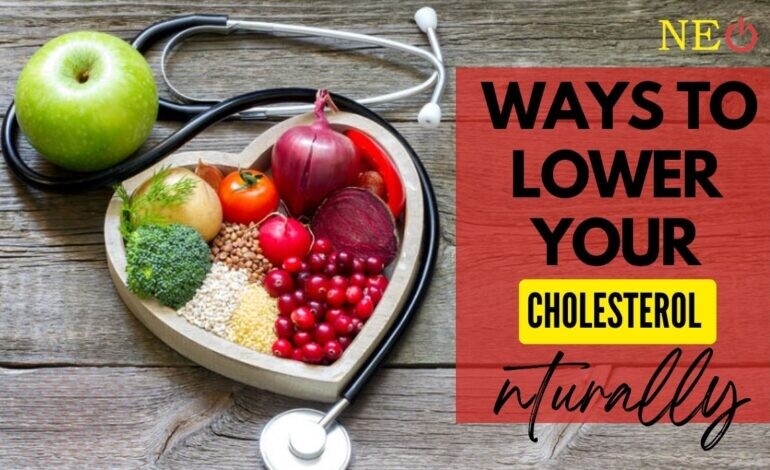What is cholesterol?
A molecule that resembles fat called cholesterol is found in all of the body's cells. The body needs cholesterol to create cell membranes and to manufacture hormones, but too much cholesterol might increase the risk of negative health effects.
- the sex hormones estrogen and testosterone
- vitamin D
- bile acids, which help the body digest fats
The entire amount of cholesterol required by the body is produced by the liver. However, certain meals have cholesterol in them, while others can make the liver generate more of it.
A person's risk of developing heart disease, having a heart attack, or having a stroke rises when they have high levels of LDL cholesterol since this can cause fatty deposits to accumulate on the artery walls.
LDL cholesterol and other fatty substances are removed from the arteries by HDL cholesterol, which then takes them back to the liver. Extra cholesterol is eliminated by the liver by being transformed into bile, which is a digestive fluid.
According to the National Heart, Lung, and Blood Institute Trusted Source, a person’s lifestyle choices are the leading cause of high cholesterol. However, genetics, certain medical conditions, and medications can also contribute to high cholesterol.
Avoid trans fats

Unsaturated fats that have undergone the industrial process of hydrogenation, which involves heating vegetable oils in the presence of hydrogen and a catalyst, are known as trans unsaturated fatty acids (trans fats). Trans fats are used in food production because they are durable and reasonably priced.
Sources of trans fats may include:
- margarine
- vegetable shortening
- partially hydrogenated vegetable oils
- fried foods
- certain processed and prepackaged foods
According to the American Heart AssociationTrusted Source (AHA), consuming trans fats can negatively affect a person’s health in two different ways. Firstly, they can raise blood levels of LDL, or “bad,” cholesterol. They may also reduce blood levels of high-density lipoprotein (HDL), or “good,” cholesterol.
LDL cholesterol can accumulate in the arteries and increase the risk of heart disease, heart attack, and stroke. HDL cholesterol helps remove LDL cholesterol from the bloodstream.
Consume fewer saturated fats

Saturated fats generally stay solid at room temperatureTrusted Source, whereas unsaturated fats are usually liquid. Dietary sources of saturated fats may include:
- red meat
- pork
- chicken with the skin on
- butter
- cheese and other dairy products
- cooking oils, such as palm oil and coconut oil
The researchers of a 2018 studyTrusted Source found that monounsaturated fat from plant sources may lower the risk of heart disease more than monounsaturated fat from animal sources.
However, the researchers highlighted that further conclusive research is necessary as the study results came from observational findings.
Eat more polyunsaturated fats

Omega-3 and omega-6 fatty acids are two examples of polyunsaturated fats. As necessary fatty acids, omega-3 and omega-6 are both recognised. Essential refers to the fact that a person can only obtain these oils directly from food sources because the body is unable to create them on its own.
According to the available data, replacing saturated fat with these fats can lower LDL cholesterol without impacting HDL cholesterol, which in turn lowers blood cholesterol levels.
Dietary sources of polyunsaturated fats includeTrusted Source:
- some types of nuts, such as walnuts
- some seeds, including sunflower seeds
- plant oils, such as soybean, corn, and sunflower oils
- other soybean products, such as tofu and edamame beans
Eat more soluble fiber

Eating foods high in fiber can be beneficialTrusted Source for blood cholesterol levels. There are two kindsTrusted Source of dietary fiber — soluble and insoluble.
When a person consumes soluble fiber, it absorbs water and creates a thick, gel-like paste in a person’s intestines. This gel helps to support digestive health and also aids in trapping fats, meaning the body cannot absorb them. As such, soluble fiber can help to lower levels of LDL cholesterol.
Foods rich in soluble fiber include:
- vegetables
- fruits
- whole grains, such as oatmeal and brown rice
- legumes
- beans
Exercise regularly

Regular exercise benefits a person’s health in many ways. This includes helping to lower bad cholesterol levels and raising good cholesterol levels.
For example, the results of a 2019 studyTrusted Source involving 425 older adults demonstrated that moderate and vigorous physical activity lowered blood pressure and blood sugar levels and increased HDL cholesterol levels.
The Department of Health and Human ServicesTrusted Source recommends that adults do at least 150–300 minutes of moderate-intensity or 75–150 minutes of vigorous-intensity aerobic physical activity a week for substantial health benefits. A person can spread this activity throughout the week.
People new to exercise may want to start with lower-intensity activities and gradually build the intensity of their workouts. Additionally, individuals with chronic conditions or disabilities should consult a doctorTrusted Source to determine what type of physical activity and how much is right for them.
Healthy sleep habits

Getting enough good-quality sleep is important for health. How much sleep a person requires changes with age, and research suggests that most adults should aim for 7 or more hoursTrusted Source of sleep per night.
Other evidenceTrusted Source indicates that there is an association between short sleep duration or poor sleep quality with higher cholesterol levels.
However, researchers are still trying to understand how sleep affects cholesterol. Some researchTrusted Source suggests that HDL levels are lower in people with insufficient sleep. Whereas other research indicates that too little or too much sleep can result in low HDL levels.
Overall, poor sleep duration and quality appear to negatively impact cholesterol, but it is not clear exactly why or how it does. Therefore, it may be beneficial for general health and cholesterol management for a person to develop good sleep hygiene practices.
Quitting smoking

Smoking can lead to high cholesterol levels as it can reduce the circulating level of HDL.
Additionally, the chemicals present in cigarette smoke can cause LDL to become stickier and also damageTrusted Source the lining of blood vessels, making them swollen and inflamed. As such, smoking can make it difficult to control cholesterol levels and increases the risk of a potential clog in the arteries.
By quitting smoking, a person can lowerTrusted Source their LDL and increase their HDL cholesterol levels. This can help to slow the buildup of new fatty deposits in arteries and support overall health.
Drinking water

The importance of regularly consuming water and getting enough cannot be overstated. dependable source of health and vital for liver wellness.
As it aids in the breakdown of cholesterol, the liver is crucial in controlling cholesterol levels. Cholesterol may accumulate in the body if the liver is unable to function properly.
2021 research
Water was linked to greater HDL cholesterol levels, according to a Trusted Source study on the benefits of hydration for metabolic health in older persons. This shows that drinking water may lower cholesterol levels in addition to being a healthy beverage option.









